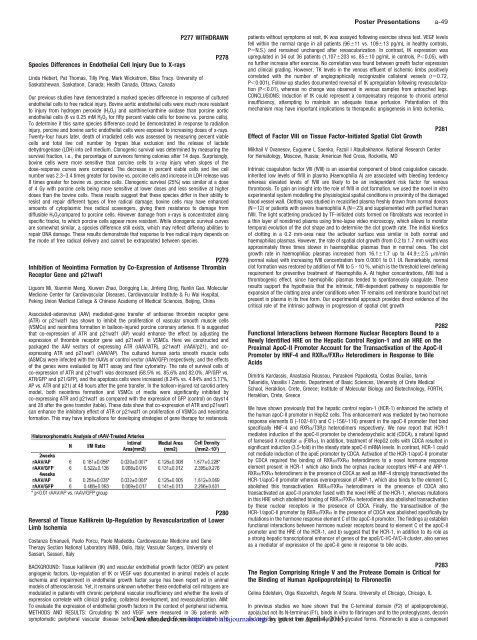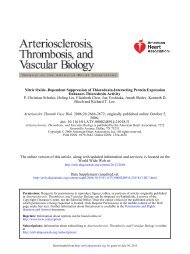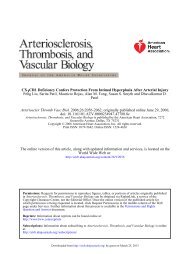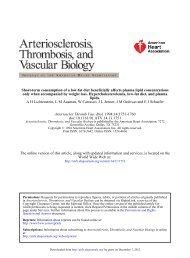Oral Presentations - Arteriosclerosis, Thrombosis, and Vascular ...
Oral Presentations - Arteriosclerosis, Thrombosis, and Vascular ...
Oral Presentations - Arteriosclerosis, Thrombosis, and Vascular ...
You also want an ePaper? Increase the reach of your titles
YUMPU automatically turns print PDFs into web optimized ePapers that Google loves.
Species Differences in Endothelial Cell Injury Due to X-rays<br />
Linda Hiebert, Pat Thomas, Tilly Ping, Mark Wickstrom, Bliss Tracy. University of<br />
Saskatchewan, Saskatoon, Canada; Health Canada, Ottawa, Canada<br />
P277 WITHDRAWN<br />
P278<br />
Our previous studies have demonstrated a marked species difference in response of cultured<br />
endothelial cells to free radical injury. Bovine aortic endothelial cells were much more resistant<br />
to injury from hydrogen peroxide (H 2O 2) <strong>and</strong> xanthine/xanthine oxidase than porcine aortic<br />
endothelial cells (6 vs 0.25 mM H 2O 2 for fifty percent viable cells for bovine vs. porcine cells).<br />
To determine if this same species difference could be demonstrated in response to radiation<br />
injury, porcine <strong>and</strong> bovine aortic endothelial cells were exposed to increasing doses of x-rays.<br />
Twenty-four hours later, death of irradiated cells was assessed by measuring percent viable<br />
cells <strong>and</strong> total live cell number by trypan blue exclusion <strong>and</strong> the release of lactate<br />
dehydrogenase (LDH) into cell medium. Clonogenic survival was determined by measuring the<br />
survival fraction, i.e., the percentage of survivors forming colonies after 14 days. Surprisingly,<br />
bovine cells were more sensitive than porcine cells to x-ray injury when slopes of the<br />
dose-response curves were compared. The decrease in percent viable cells <strong>and</strong> live cell<br />
number was 2.3–3.4 times greater for bovine vs. porcine cells <strong>and</strong> increase in LDH release was<br />
8 times greater for bovine vs. porcine cells. Clonogenic survival (25%) was similar at a dose<br />
of 4 Gy with porcine cells being more sensitive at lower doses <strong>and</strong> less sensitive at higher<br />
doses than the bovine cells. These results suggest that these species differ in their ability to<br />
resist <strong>and</strong> repair different types of free radical damage; bovine cells may have enhanced<br />
amounts of cytoplasmic free radical scavengers, giving them resistance to damage from<br />
diffusible H 2O 2compared to porcine cells. However damage from x-rays is concentrated along<br />
specific tracks, to which porcine cells appear more resistant. While clonogenic survival curves<br />
are somewhat similar, a species difference still exists, which may reflect differing abilities to<br />
repair DNA damage. These results demonstrate that response to free radical injury depends on<br />
the mode of free radical delivery <strong>and</strong> cannot be extrapolated between species.<br />
P279<br />
Inhibition of Neointima Formation by Co-Expression of Antisense Thrombin<br />
Receptor Gene <strong>and</strong> p21waf1<br />
Liguom Mi, Xianmin Meng, Xiuwen Zhao, Dongqing Liu, Jinfeng Ding, Runlin Gao. Molecular<br />
Medicine Center for Cardiovascular Diseases, Cardiovascular Institute & Fu Wai Hospital,<br />
Peking Union Medical College & Chinese Academy of Medical Sciences, Beijing, China<br />
Associated-adenovirus (AAV) mediated-gene transfer of antisense thrombin receptor gene<br />
(ATR) or p21waf1 has shown to inhibit the proliferation of vascular smooth muscle cells<br />
(VSMCs) <strong>and</strong> neointima formation in balloon-injured porcine coronary arteries. It is suggested<br />
that co-expression of ATR <strong>and</strong> p21waf1 (AP) would enhance the effect by adjusting the<br />
expression of thrombin receptor gene <strong>and</strong> p21waf1 in VSMCs. Here we constructed <strong>and</strong><br />
packaged the AAV vectors of expressing ATR (rAAV/ATR), p21waf1 (rAAV/p21), <strong>and</strong> coexpressing<br />
ATR <strong>and</strong> p21waf1 (rAAV/AP). The cultured human aorta smooth muscle cells<br />
(ASMCs) were infected with the rAAVs or control vector (rAAV/GFP) respectively, <strong>and</strong> the effects<br />
of the genes were evaluated by MTT assay <strong>and</strong> flow cytometry. The rate of survival cells of<br />
co-expression of ATR <strong>and</strong> p21waf1 was decreased (68.5% vs. 85.6% <strong>and</strong> 82.0%, AP/GFP vs.<br />
ATR/GFP <strong>and</strong> p21/GFP), <strong>and</strong> the apoptosis cells were increased (8.24% vs. 4.84% <strong>and</strong> 5.17%,<br />
AP vs. ATR <strong>and</strong> p21) at 48 hours after the gene transfer. In the balloon-injured rat carotid artery<br />
model, both neointima formation <strong>and</strong> VSMCs of media were significantly inhibited by<br />
co-expressing ATR <strong>and</strong> p21waf1 as compared with the expression of GFP (control) on days14<br />
<strong>and</strong> 28 after the gene transfer (table). These data show that co-expression of ATR <strong>and</strong> p21waf1<br />
can enhance the inhibitory effect of ATR or p21waf1 on proliferation of VSMCs <strong>and</strong> neointima<br />
formation. This may have implications for developing strategies of gene therapy for restenosis.<br />
P280<br />
Reversal of Tissue Kallikrein Up-Regulation by Revascularization of Lower<br />
Limb Ischemia<br />
Costanza Emanueli, Paolo Porcu, Paolo Madeddu. Cardiovascular Medicine <strong>and</strong> Gene<br />
Therapy Section National Laboratory INBB, Osilo, Italy; <strong>Vascular</strong> Surgery, University of<br />
Sassari, Sassari, Italy<br />
BACKGROUND: Tissue kallikrein (tK) <strong>and</strong> vascular endothelial growth factor (VEGF) are potent<br />
angiogenic factors. Up-regulation of tK or VEGF was documented in animal models of acute<br />
ischemia <strong>and</strong> impairment in endothelial growth factor surge has been report ed in animal<br />
models of atherosclerosis. Yet, it remains unknown whether these endothelial cell mitogens are<br />
modulated in patients with chronic peripheral vascular insufficiency <strong>and</strong> whether the levels of<br />
expression correlate with clinical grading, collateral development, <strong>and</strong> revascularization. AIM:<br />
To evaluate the expression of endothelial growth factors in the context of peripheral ischemia.<br />
METHODS AND RESULTS: Circulating tK <strong>and</strong> VEGF were measured in 36 patients with<br />
symptomatic peripheral vascular disease beforeDownloaded <strong>and</strong> after surgical from<br />
revascularization. In 6<br />
Poster <strong>Presentations</strong> a-49<br />
patients without symptoms at rest, tK was assayed following exercise stress test. VEGF levels<br />
fell within the normal range in all patients (9611 vs. 10913 pg/mL in healthy controls,<br />
PN.S.) <strong>and</strong> remained unchanged after revascularization. In contrast, tK expression was<br />
upregulated in 34 out 36 patients (1,107203 vs. 8510 pg/mL in controls, P0.05), with<br />
no further increase after exercise. No correlation was found between growth factor expression<br />
<strong>and</strong> clinical grading. However, TK levels in the venous effluent of ischemic limbs positively<br />
correlated with the number of angiographically recognizable collateral vessels (r0.72,<br />
P0.001). Follow-up studies documented reversal of tK upregulation following revascularization<br />
(P0.01), whereas no change was observed in venous samples from untouched legs.<br />
CONCLUSIONS: Induction of tK could represent a compensatory response to chronic arterial<br />
insufficiency, attempting to maintain an adequate tissue perfusion. Potentiation of this<br />
mechanism may have important implications to therapeutic angiogenesis in limb ischemia.<br />
Effect of Factor VIII on Tissue Factor-Initiated Spatial Clot Growth<br />
Mikhail V Ovanesov, Euguene L Saenko, Fazoil I Ataullakhanov. National Research Center<br />
for Hematology, Moscow, Russia; American Red Cross, Rockville, MD<br />
P281<br />
Intrinsic coagulation factor VIII (fVIII) is an essential component of blood coagulation cascade.<br />
Inherited low levels of fVIII in plasma (Haemophilia A) are associated with bleeding tendency<br />
whereas elevated levels of fVIII are likely to be an independent risk factor for venous<br />
thrombosis. To gain an insight into the role of fVIII in clot formation, we used the novel in vitro<br />
experimental system modelling the physiological spatial conditions in proximity of the damaged<br />
blood vessel wall. Clotting was studied in recalcified plasma freshly drawn from normal donors<br />
(N12) or patients with severe haemophilia A (N23) <strong>and</strong> supplemented with purified human<br />
fVIII. The light scattering produced by TF-initiated clots formed on fibroblasts was recorded in<br />
a thin layer of nonstirred plasma using time-lapse video microscopy, which allows to monitor<br />
temporal evolution of the clot shape <strong>and</strong> to determine the clot growth rate. The initial kinetics<br />
of clotting in a 0.2 mm-area near the activator surface was similar in both normal <strong>and</strong><br />
haemophiliac plasmas. However, the rate of spatial clot growth (from 0.2 to 1.7 mm width) was<br />
approximately three times slower in haemophiliac plasmas than in normal ones. The clot<br />
growth rate in haemophiliac plasmas increased from 16.11.7 up to 44.92.5 m/min<br />
(normal value) with increasing fVIII concentration from 0.0001 to 0.1 UI. Remarkably, normal<br />
clot formation was restored by addition of fVIII to 5 - 10 %, which is the threshold level defining<br />
requirement for preventive treatment of Haemophilia A. At higher concentrations, fVIII had a<br />
thrombogenic effect, since haemophilic plasmas tended to spontaneously coagulate. These<br />
results support the hypothesis that the intrinsic, fVIII-dependent pathway is responsible for<br />
expansion of the clotting area under conditions when TF remains cell membrane bound but not<br />
present in plasma in its free form. Our experimental approach provides direct evidence of the<br />
critical role of the intrinsic pathway in progression of spatial clot growth<br />
P282<br />
Functional Interactions between Hormone Nuclear Receptors Bound to a<br />
Newly Identified HRE on the Hepatic Control Region-1 <strong>and</strong> an HRE on the<br />
Proximal ApoC-II Promoter Account for the Transactivation of the ApoC-II<br />
Promoter by HNF-4 <strong>and</strong> RXR/FXR Heterodimers in Response to Bile<br />
Acids<br />
Dimitris Kardassis, Anastasia Roussou, Paraskevi Papakosta, Costas Boulias, Iannis<br />
Talianidis, Vassilis I Zannis. Department of Basic Sciences, University of Crete Medical<br />
School, Heraklion, Crete, Greece; Institute of Molecular Biology <strong>and</strong> Biotechnology, FORTH,<br />
Heraklion, Crete, Greece<br />
We have shown previously that the hepatic control region-1 (HCR-1) enhanced the activity of<br />
the human apoC-II promoter in HepG2 cells. This enhancement was mediated by two hormone<br />
response elements B (-102/-81) <strong>and</strong> C (-156/-116) present in the apoC-II promoter that bind<br />
specifically HNF-4 <strong>and</strong> RXR/T3R heterodimers respectively. We now report that HCR-1<br />
mediates induction of the apoC-II promoter by chenodeoxycholic acid (CDCA), a natural lig<strong>and</strong><br />
of farnesoid X receptor (FXR). In addition, treatment of HepG2 cells with CDCA resulted in<br />
significant induction (3.5-fold) in the steady state apoC-II mRNA levels. In contrast, HCR-1 could<br />
not mediate induction of the apoE promoter by CDCA. Activation of the HCR-1/apoC-II promoter<br />
by CDCA required the binding of RXR/FXR heterodimers to a novel hormone response<br />
element present in HCR-1 which also binds the orphan nuclear receptors HNF-4 <strong>and</strong> ARP-1.<br />
RXR/FXR heterodimers in the presence of CDCA as well as HNF-4 strongly transactivated the<br />
HCR-1/apoC-II promoter whereas overexpression of ARP-1, which also binds to the element C,<br />
abolished this transactivation. RXR/FXR heterodimers in the presence of CDCA also<br />
transactivated an apoC-II promoter fused with the novel HRE of the HCR-1, whereas mutations<br />
in this HRE which abolished binding of RXR/FXR heterodimers also abolished transactivation<br />
by these nuclear receptors in the presence of CDCA. Finally, the transactivation of the<br />
HCR-1/apoC-II promoter by RXR/FXR in the presence of CDCA was abolished specifically by<br />
mutations in the hormone response element C of the apoC-II promoter. The findings a) establish<br />
functional interactions between hormone nuclear receptors bound to element C of the apoC-II<br />
promoter <strong>and</strong> the HRE of the HCR-1, <strong>and</strong> b) suggest that the HCR-1, in addition to its role as<br />
a strong hepatic transcriptional enhancer of genes of the apoE/C-I/C-IV/C-II cluster, also serves<br />
as a mediator of expression of the apoC-II gene in response to bile acids.<br />
P283<br />
The Region Comprising Kringle V <strong>and</strong> the Protease Domain is Critical for<br />
the Binding of Human Apolipoprotein(a) to Fibronectin<br />
Celina Edelstein, Olga Klezovitch, Angelo M Scanu. University of Chicago, Chicago, IL<br />
In previous studies we have shown that the C-terminal domain (F2) of apolipoprotein(a),<br />
apo(a),but not its N-terminus (F1), binds in vitro to fibrinogen <strong>and</strong> to the proteoglycans, decorin<br />
http://atvb.ahajournals.org/ <strong>and</strong> biglycan, by both guest in their on April glycated4, <strong>and</strong> 2013 non-glycated forms. Fibronectin is also a component














